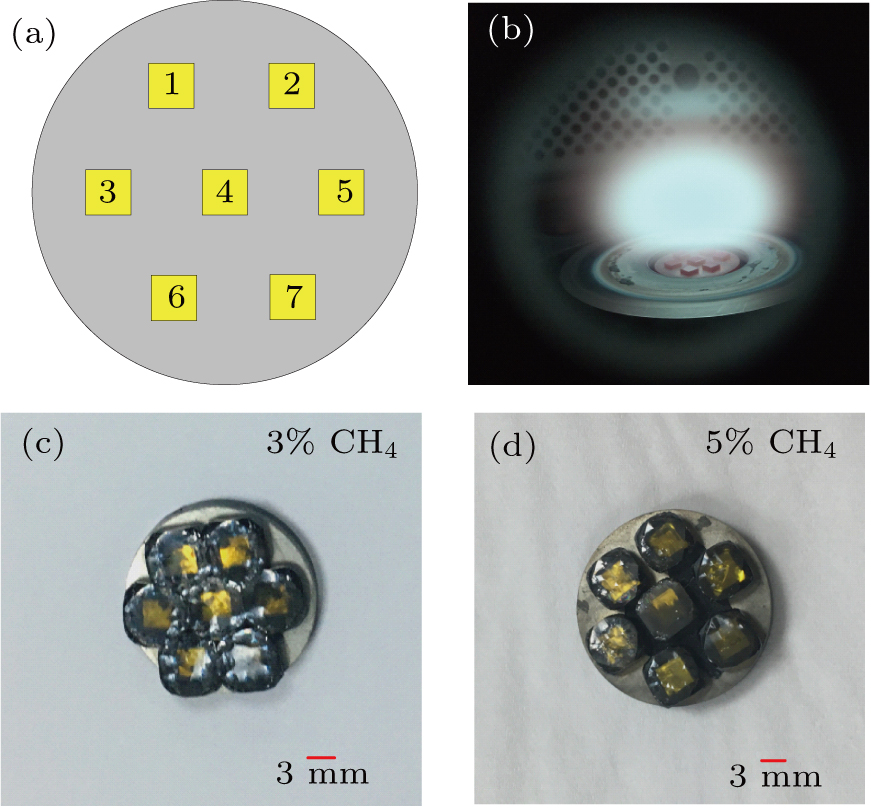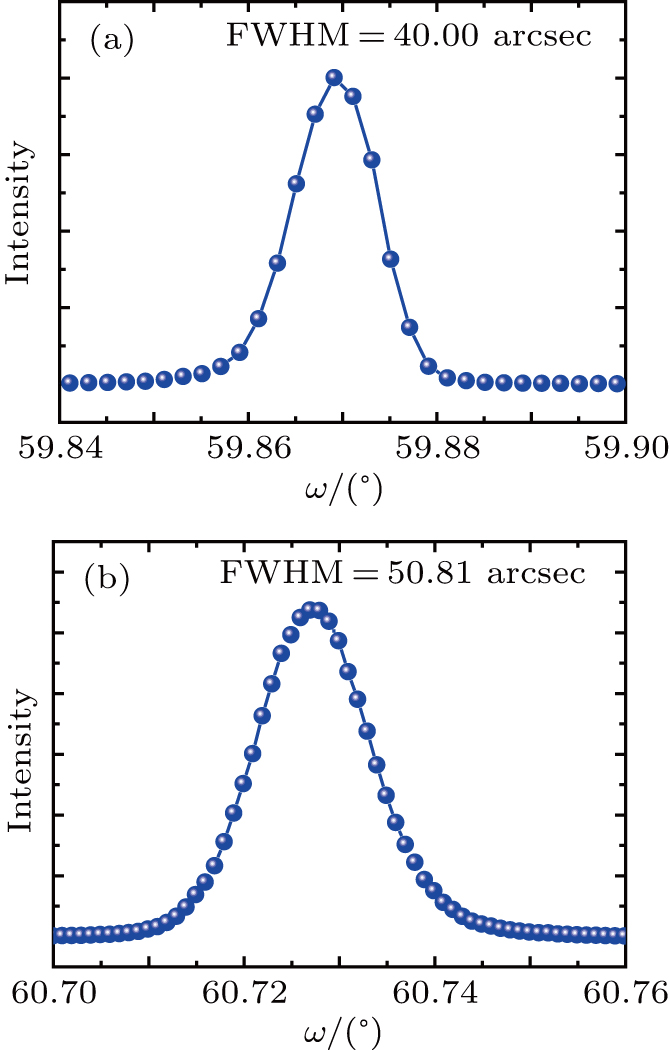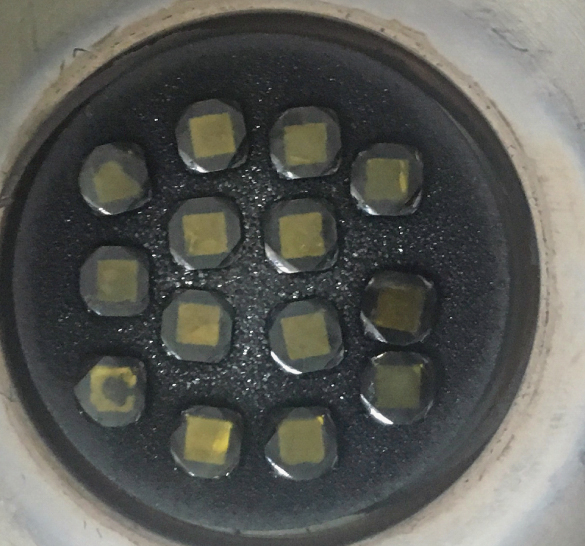† Corresponding author. E-mail:
Project supported by the National Key Research and Development Program of China (Grant Nos. 2018YFB0406504 and 2016YFB0400105) and the National Postdoctoral Program for Innovative Talents, China (Grant No. BX20190263).
We report the simultaneous enlarged growth of seven single crystal diamond (SCD) plates free from polycrystalline diamond (PCD) rim by using a microwave plasma chemical vapor deposition (MPCVD) system. Optical microscope and atomic force microscope (AFM) show the typical step-bunching SCD morphology at the center, edge, and corner of the samples. The most aggressively expanding sample shows a top surface area three times of that of the substrate. The effective surface expanding is attributed to the utilization of the diamond substrates with (001) side surfaces, the spacial isolation of them to allow the sample surface expanding, and the adoption of the reported pocket holder. Nearly constant temperature of the diamond surfaces is maintained during growth by only decreasing the sample height, and thus all the other growth parameters can be kept unchanged to achieve high quality SCDs. The SCDs have little stress as shown by the Raman spectra. The full width at half maximum (FWHM) data of both the Raman characteristic peak and (004) x-ray rocking curve of the samples are at the same level as those of the standard CVD SCD from Element Six Ltd. The nonuniformity of the sample thickness or growth rate is observed, and photoluminescence spectra show that the nitrogen impurity increases with increasing growth rate. It is found that the reduction of the methane ratio in the sources gas flow from 5% to 3% leads to decrease of the vertical growth rate and increase of the lateral growth rate. This is beneficial to expand the top surface and improve the thickness uniformity of the samples. At last, the convenience of the growth method transferring to massive production has also been demonstrated by the successful simultaneous enlarged growth of 14 SCD samples.
Due to its exceptional properties, such as wide bandgap, high carrier mobility, high thermal conductivity, extreme hardness, diamond has tremendous advantages to be used as a semiconductor, heat sink, cutting tools, or gems.[1–5] The single crystal diamond (SCD) has better properties than the polycrystalline diamond (PCD), since it has no grain boundaries. However, the lack of the large diamond substrate blocks the development of the SCD severely. The commercially available SCD plates larger than 5 mm × 5 mm are very expensive. What is more, the growth rate of high quality SCD is usually lower than ten microns per hour.[6] Thus, it is of great interest to develop the methods that could obtain the SCD with high crystal quality, high growth rate, or even multiple growth.[7,8]
Previously the multiple-substrate growth processes including the so-called “mosaic” or “multiple” growth have been developed.[9–13] In these processes, the substrates are usually placed exactly side by side. However, the PCD rims easily appear at the seams among the substrates during the growth, which induces the shrinkage of the top surface of the grown SCD. Recently, it is found that the pocket-type substrate holder and the constant growth temperature are effective to eliminate the PCD rims during the growth,[14,15] and we also have achieved the laterally enlarged growth of the single crystal diamond by using a microwave plasma chemical vapor deposition (MPCVD) system.[16]
In this paper, we report the simultaneous enlarging growth of the multiple SCD plates by using the MPCVD system. The substrates are placed apart from each other. During growth, the temperature of the SCD surface is kept constant by reducing the height of the substrate without changing any growth parameters. After growth, the expanded SCD surfaces without any PCD rims are achieved, and the property and uniformity of the grown SCDs are investigated.
The commercially available high-temperature high-pressure (HTHP) grown type-Ib (001) substrates were used. The size of the substrates is 3 mm × 3 mm × 1.5 mm. Based on our previous investigation,[16] we found that the substrate with four (100) side surfaces can achieve the effective enlargement. Thus, all samples used in this work have (100) top and side surfaces.
The growth was performed in an MPCVD system with the microwave power and frequency of 6 kW and 2.45 GHz, respectively. Before growth, the substrates were etched in the hydrogen plasma with 2% oxygen added to eliminate the surface defects induced by mechanical polishing, and the surface with low dislocation density was chosen for the growth. Then, we brazed all the substrates on a circular molybdenum holder using 25-μm-thick gold foil to obtain the stable thermal exchange between the substrates and the holder during growth. All molybdenum holders have the same diameter of 20 mm. The samples placed apart from each other are marked as Nos. 1–7, as shown in Fig.
The as-grown samples using different CH4 densities of 3% and 5% are shown in Figs.
| Table 1. Summary of the thickness and growth rate of the diamond epilayers. . |
With the decreasing methane density, the growth rate apparently decreases. For the samples grown with 3% CH4 density, the lateral growth leads to the side connection among the samples after the long time growth. However, we can observe that there is still no PCD appearing in the connecting interfaces between the samples. However, some bulges can be observed around the sample sides due to generation of defects and related abnormal nucleation/growth, and this is completely different from the PCD rims. One can also find that the ratio of the growth rate in the batch of samples could reach a maximum of 15.2/8.6 = 177% for the samples grown with 5% methane and 6.7/5.2 = 129% for the samples grown with 3% methane. This indicates the thickness nonuniformity of the latter is much smaller compared with that of the former. As a result, proper reduction of the methane ratio in the sources gas flow in the multiple growth of CVD SCDs by our method is beneficial to expand the top surface and improve the thickness uniformity of the samples.
As above mentioned, we can maintain the temperature of the SCD surfaces almost constant by only decreasing the sample height, and thus all the other growth parameters (microwave power, pressure, etc.) can be kept unchanged. As shown in Fig.
 | Fig. 2. Sample holder height versus growth time for the samples grown with (a) 3% and (b) 5% CH4 density. |
The maintenance of the constant temperature at the sample surface has been reported to be very important to obtain high quality and PCD rimless SCD, and has realized by continuously decreasing the input microwave power.[15] However, this method is in principle not suitable for multiple growth because the decrease of the microwave power will cause the compression of the plasma and aggregate the growth nonuniformity among samples. Moreover, the change of the growth parameter easily leads to the change of impurity incorporation or lattice constant, then induces the internal stress or defects. Compared to the reported method in Ref. [15], our method does not change any growth parameters. Thus, little internal stress or dislocations would be induced. Figure
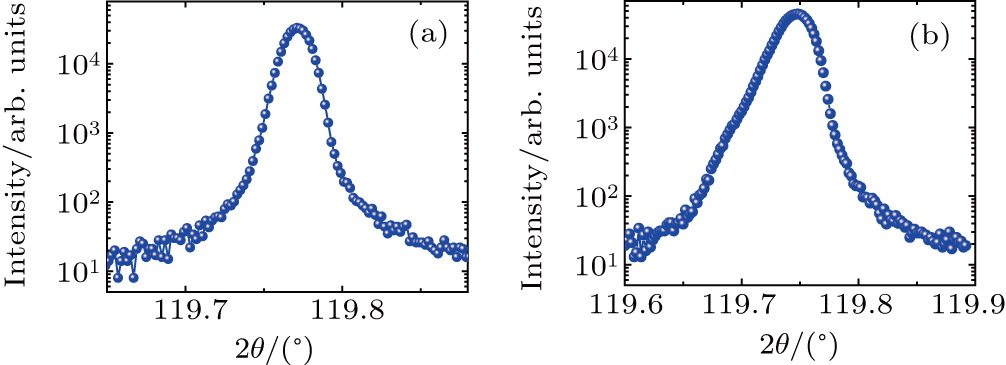 | Fig. 3. The XRD (004) 2θ–ω results of the CVD SCDs (a) with and (b) without constant growth parameters. |
The surface morphologies of the as-grown samples of both batches (Fig.
Figure
 | Fig. 6. (a) Picture of the substrates and the CVD SCDs and (b) the positions of the Raman characteristic peak of diamond of both batches of CVD SCDs. |
We measured the Raman spectra of the samples to characterize the stress in the CVD SCDs. For all the samples, the Raman characteristic peak of diamond[19] appears near 1332.5 cm−1 (Fig.
In order to investigate the incorpration of nitrogen and optical properties of the samples, the PL spectra were measured (Fig.
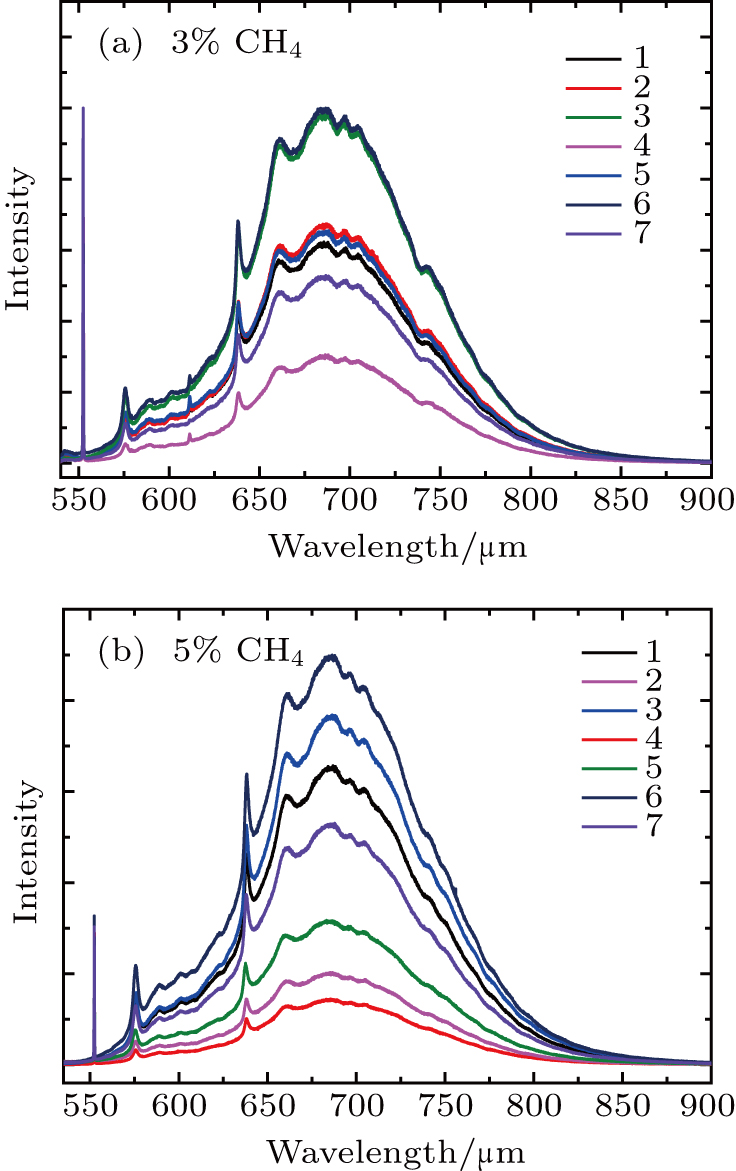 | Fig. 7. Results of PL measurement for the samples grown with the CH4 densities of (a) 3% and (b) 5%. |
We also used XRD to characterize the crystalline quality of the samples grown with different CH4 density. The typical results are shown in Fig.
As a further demonstration of the multiple growth ability, we also achieved the simultaneous growth of over ten SCD samples. Figure
We have achieved the simultaneous enlarged growth of seven SCD samples by using an MPCVD system and investigated their properties. The substrates are brazed on a pocket holder to achieve the stable and uniform heat exchange, and separated from each other to allow the sample surface expanding. After the growth at almost a constant temperature, all the diamond plates have larger and PCD-rimless top surfaces clarified by the typical step-bunching SCD morphology at the center, edge, and corner of the samples observed by optical microscope and AFM. The most aggressively expanding sample shows a top surface area three times of that of the substrate. The SCDs have little stress as shown by the Raman spectra. The FWHM data of both the Raman characteristic peak and (004) XRD rocking curve of the samples are at the same level as those of the standard CVD SCD from Element Six Ltd, which hints the high quality of our samples. The nonuniformity of the sample thickness or growth rate is observed, and PL spectra show that the nitrogen impurity increases with increasing growth rate. We also find that proper reduction of the methane ratio in the sources gas flow is beneficial to expand the top surface and improve the thickness uniformity of the samples. At last, the convenience of the growth method transferring to massive production has also been demonstrated by the successful simultaneous enlarged growth of 14 SCD samples.
| [1] | |
| [2] | |
| [3] | |
| [4] | |
| [5] | |
| [6] | |
| [7] | |
| [8] | |
| [9] | |
| [10] | |
| [11] | |
| [12] | |
| [13] | |
| [14] | |
| [15] | |
| [16] | |
| [17] | |
| [18] | |
| [19] | |
| [20] |


